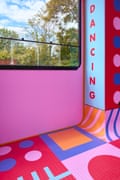This summer brings a new way to deal with grief. It’s not a helpline or a new antidepressant – instead artist Annie Frost Nicholson has created a disco where you can dance away your existential pain.
The Fandangoe Discoteca, a brightly coloured kiosk whose design is inspired by De Stijl and postmodernist architect Ettore Sottsass and which holds up to eight dancers, arrives at London’s Canary Wharf this month before touring the UK and Europe over the summer.
As well as DJ sets, there’ll be meditation and yoga workshops, dance classes and “grief raves” where clubbers can request tracks which remind them of absent or lost loved ones.
“It’s a non-traditional way of accessing the complex, universal subject of grief,” says Nicholson. “I like to find a hook to help people access their feelings without being prescriptive.”
This mini disco is a collaboration between Nicholson and the Loss Project, a social enterprise focused on ways of processing grief. It’s the artist’s latest work looking at ways to deal with grief in various forms – bereavement, climate grief, political grief and mental health issues.
The artist has made uplifting art about tragedy since she lost most of her family in 2011. Her mother, sister and sister’s partner were killed in a helicopter crash while celebrating her sister’s birthday with a sightseeing tour around New York. Her father survived the accident, but he had terminal cancer and died a few years later.
For some time after her loss, Nicholson couldn’t make art at all and worked as a teacher. Then she invented an alter ego that let her explore her grief. As the Fandangoe Kid, she made graphic public art, and in 2021 took an ice-cream van – the Fandangoe Whip – around the UK to serve therapy, workshops and sorbet to the public. When she took it to New York in the summer of 2022, she held the first grief rave and found how much people wanted to dance through their feelings.
“Over the past few years we’ve been listening to public ideas about grief,” says Nicholson. “Post-pandemic, people were desperate to share their experiences and talk – words were falling out of their mouths. Now there’s a real shift to wanting to shake it out.”
Dance is used in death rituals around the world, such as in Māori, Yoruba and Jamaican cultures, but cathartic movement doesn’t feature in traditional British approaches to grief.
“The UK has changed in terms of being more open about grief, but it remains stigmatised,” says Carly Attridge, founder of the Loss Project. “Many people tell me that after a bereavement friends or relatives ignore them because they don’t know what to say, so they avoid the situation, which can be very isolating. Using the arts, podcasts, blogs, dance and even boxing has shown me that there are many faces of grief and also a desire to understand grief in different ways.”
Emma Warren, author of the dancefloor history book Dance Your Way Home, had recent experience of death and dancing when a friend died suddenly in his early 30s. “His parents are Jamaican, and after the church service and burial, there was a DJ and dancing. It struck me as really sensible. Taking to the dancefloor after such a long, painful day offered hope.”
She says that dance is undervalued in British culture. “Improvised dance – where you just move to show how you feel – improves divergent thinking and the ability to solve problems. But we generally don’t consider ordinary dancers who aren’t particularly good to be valuable even though the dancefloor can be a site of solidarity, repair and even healing.”
The Fandangoe Discoteca will also be a wake for the Fandangoe Kid. Nicholson has decided this will be the last project using the moniker – which came from a childhood family nickname. From now on, she’ll create art as Annie Frost Nicholson. Frost is her mother’s maiden name. “I introduced the alter ego so I could navigate everything that’s happened in the last 12 years,” says Nicholson. “But I don’t need to hide now. I’m not afraid of the depths any more.”

